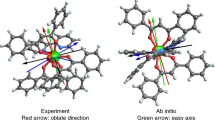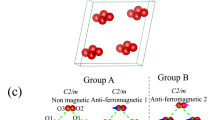Abstract
WE have read with interest the recent paper by Weiss1 concerning the electronic structure of oxygenated hæmoglobin. From a consideration of: (1) magnetic properties, (2) absorption spectrum and (3) acid dissociation constant of oxygenated hæmoglobin, Weiss has proposed that the iron has a +3 charge. Therefore, iron is essentially in the ferric state. His paper has prompted us to give additional evidence in support of his idea.
This is a preview of subscription content, access via your institution
Access options
Subscribe to this journal
Receive 51 print issues and online access
$199.00 per year
only $3.90 per issue
Buy this article
- Purchase on Springer Link
- Instant access to full article PDF
Prices may be subject to local taxes which are calculated during checkout
Similar content being viewed by others
References
Weiss, J. J., Nature, 202, 83 (1964).
Ballhausen, C. J., Introduction to Ligand Field Theory, 152 (McGraw-Hill Book Company, Inc., New York, 1962).
Muller, Norbert, Pickett, Lucy W., and Mulliken, Robert S., J. Amer. Chem. Soc., 76, 4770 (1954).
Pauling, L., in Roughton, F. J. W., and Kendrew, J. C., Joseph Bancroft Memorial Symposium on Hemoglobin, 57 (Interscience Pub. Due., New York, 1949).
Author information
Authors and Affiliations
Rights and permissions
About this article
Cite this article
VIALE, R., MAGGIORA, G. & INGRAHAM, L. Molecular Orbital Evidence for Weiss's Oxyhæmoglobin Structure. Nature 203, 183–184 (1964). https://doi.org/10.1038/203183b0
Issue Date:
DOI: https://doi.org/10.1038/203183b0
This article is cited by
-
Mechanism of autoxidation of oxyhaemoglobin
Journal of Biosciences (1991)
-
Extended H�ckel calculations on the bonding in oxyhaemoglobin
Theoretica Chimica Acta (1971)
Comments
By submitting a comment you agree to abide by our Terms and Community Guidelines. If you find something abusive or that does not comply with our terms or guidelines please flag it as inappropriate.



